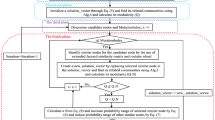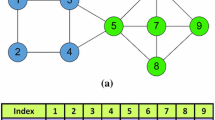Abstract
Network model recently has become a popular tool for studying complex systems. Detecting meaningful natural groups of nodes called communities in complex networks is an important task in network modeling and analysis. In this paper, the automatic network community detection is formulated as an optimization problem facilitated by node attraction. The basic idea is envision a network as a system of nodes where each node is attracted by its local neighbors. An evolution community detection algorithm is introduced, which employs a metric, named modularity Q as the fitness function and applies node attraction and modularity-based grouping crossover operator. The proposed algorithm faithfully captures the natural communities with high quality. Node attraction is easy to use for the speed up of the convergence of evolution algorithm to better partitions and for making the algorithm more stable. Node attraction does not require any threshold value. Experiments on synthetic and real-world networks further demonstrate the effectiveness of the proposed approach.






Similar content being viewed by others
References
Brandes U, Delling D, Gaertler M, Gorke R, Hoefer M, Nikoloski Z, Wagner D (2008) On modularity clustering. IEEE Trans Knowl Data Eng 20(2):172–188
Danon L, Diaz-Guilera A, Duch J, Arenas A (2005) Comparing community structure identification. J Stat Mech: Theory Exp 2005(09):P0900
Deb K (2001) Multi-Objective Optimization using Evolutionary Algorithms. Wiley, Chichester
Deb K, Pratap A, Agarwal SA, Meyarivan T (2002) A Fast and Elitist Multiobjective Genetic Algorithm: NSGA-II. IEEE Trans Evol Comput 6(2):182–197
Dorogovtsev SN, Mendes JFF (2003) Evolution of Networks: From Biological Nets to the Internet and WWW. Oxford University Press, Oxford
Fortunato S (2010) Community detection in graphs. Phys Rep 486(3):75–114
Fortunato S, Barthélemy M (2007) Resolution limit in community detection. Proc Natl Acad Sci U S A 104(1):36–41
Garey MR, Johnson DS (1979) Computers and intractability: a guide to the theory of NP completeness. W. H. Freeman, New York
Girvan M, Newman MEJ (2002) Community structure in social and biological networks. Proc Natl Acad Sci USA 99:7821–7826
Girvan M, Newman ME (2002) Community structure in social and biological networks. Proc Natl Acad Sci USA 99(12):7821–7826
Gong M, Fu B, Jiao L, Du H (2011) A memetic algorithm for community detection in networks. Phys Rev E 84(5):05610
Gong M, Chen X, Ma L, Zhang Q, Jiao L (2013) Identification of multi-resolution network structures with multi-objective immune algorithm. Appl Soft Comput 13:1705–1717
Hu Y, Yang Bo, Wong H-S (2016) A weighted local view method based on observation over ground truth for community detection. Inf Sci 355–356:37–57
Li Y, Liu J, Liu C (2014) A comparative analysis of evolutionary and memetic algorithms for community detection from signed social networks. Soft Comput 18(2):329–348
Lu Z, Sun X, Wen Y, Cao G, La Porta T (2015) Algorithms and applications for community detection in weighted networks. IEEE Trans Parallel Distrib Syst 26(11):2916–2926
Lusseau D, Schneider K, Boisseau OJ, Haase P, Slooten E, Dawson SM (2003) The bottlenose dolphin community of Doubtful Sound features a large proportion of long-lasting associations. Behav Ecol Sociobiol 54:396–405
Ma L, Gong M, Liu J, Cai Q, Jiao L (2014) Multi-level learning based memetic algorithm for community detection. Appl Soft Comput 19:121–133
Newman MEJ (2001) The structure and function of complex networks. SIAM Rev 2(45):167–256
Park Y, Song M (1998) A genetic algorithm for clustering problems. In: Proceedings of the third annual conference on genetic programming. pp 568–557
Pizzuti C (2008) Ga-net: a genetic algorithm for community detection in social networks. In: PPSN. pp 1081–1090
Pizzuti C (2012) A multiobjective genetic algorithm to find communities in complex networks. IEEE Trans Evol Comput 16:418–430
Pizzuti C (2017) Evolutionary computation for community detection in networks: a review. Trans Evolut Comput. https://doi.org/10.1109/TEVC.2017.2737600
Pothen A, Sinmon H, Liou K-P (1990) Partitioning sparse matrices with eigenvectors of graphs. SIAM J Matrix Anal Appl 11:430–452
Radicchi F, Castellano C, Cecconi F, Loreto V, Parisi D (2004) Defining and identifying clusters in networks. Proc Natl Acad Sci USA 9(101):2658–2663
Rizman Žalik K, Žalik B (2017) Multi-objective evolutionary algorithm using problem-specific genetic operators for community detection in networks. Neural Comput Appl. https://doi.org/10.1007/s00521-017-2884-0
RizmanŽalik K (2015) Maximal neighbor similarity reveals real communities in networks. Sci Rep 5:1837
Schuetz P, Caflish A (2008) Efficient modularity optimization by multistep greedy algorithm and node refinement. Phys Rev E 77(4):046112
Shi J, Malik J (1997) Normalized cuts and image segmentation. IEEE Trans PAMI 22:888–905
Shi C, Yan Z, Cai Y, Wu B (2012) Multi-objective community detection in complex networks. Appl Soft Comput 12:850–85
Srinivas N, Deb Kalyanmoy (1994) Multiobjective optimization using nondominated sorting in genetic algorithms. Evolitionary Computation 2(3):221–248
Strogatz SH (2001) Exploring complex networks. Nature 410:268–276
Tasgin M, Herdagdelen A, Bingol H (2007) Community detection in complex networks using genetic algorithms. arXiv: 0711.0491
Wu P, Pan L (2015) Multi-objective community detection based on memetic algorithm. PloS ONE 10:e0126845
Zachary WW (1977) An information flow model for conflict and fission in small groups. J Anthropol Res 33:452–473
Acknowledgements
This work was supported by the Slovenian Research Agency (grant numbers: P2-0041, J2-8176).
Author information
Authors and Affiliations
Corresponding author
Ethics declarations
Conflict of interest
The authors declare that they have no conflict of interest.
Ethical approval
This article does not contain any studies with human participants or animals performed by any of the authors.
Additional information
Communicated by V. Loia.
Publisher's Note
Springer Nature remains neutral with regard to jurisdictional claims in published maps and institutional affiliations.
Rights and permissions
About this article
Cite this article
Rizman Žalik, K., Žalik, B. Node attraction-facilitated evolution algorithm for community detection in networks. Soft Comput 23, 6135–6143 (2019). https://doi.org/10.1007/s00500-018-3267-x
Published:
Issue Date:
DOI: https://doi.org/10.1007/s00500-018-3267-x




